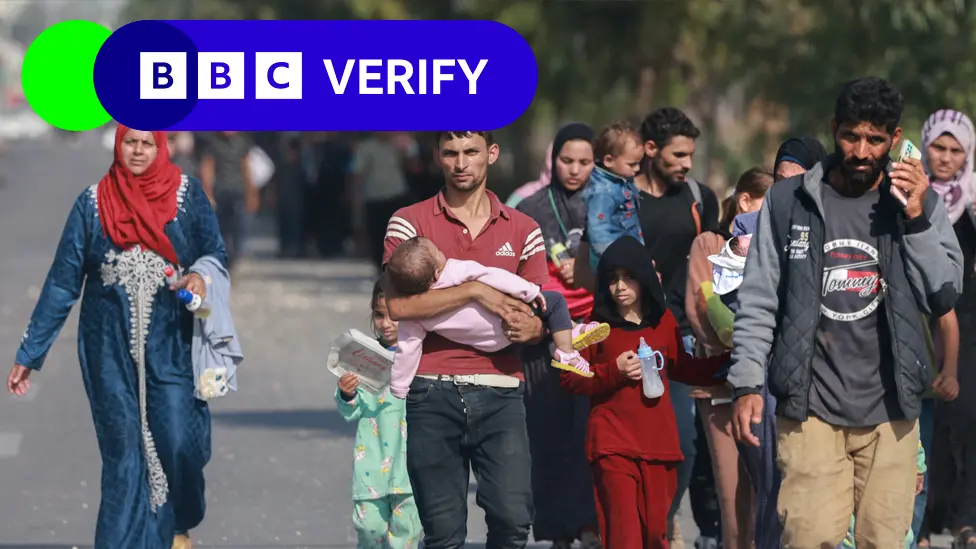How are people fleeing the fighting in northern Gaza?
People in Gaza who have fled the intense fighting in the north have been describing their journey south, along a road Israel has advised them to use.

Some recall seeing decomposing bodies on the Salah al-Din road and Israeli tanks next to it. The Israel Defence Forces (IDF) have told people in northern Gaza - via social media and leaflets - to use this highway, calling it a "safe road" at specific times of day.
So what is this journey like?
BBC Verify has been looking at video, listening to eyewitness testimony and analysing satellite images to try to get a clearer picture.
Before the fighting started, northern Gaza was home to over one million people.
It has been heavily bombed and Israeli ground forces are now fighting Hamas there, following the group's attack on Israel on 7 October.
Salah al-Din is the main road running the length of Gaza and the Israeli military has told civilians to use it as an evacuation route. The road is more than nine miles from the top of Gaza to Wadi Gaza, a valley the IDF uses to divide northern and southern Gaza.
The IDF has said people will be safer in southern Gaza although its air strikes there have continued.
A map of Gaza showing Salah al-Din Road, the main evaucation routes from the north to below the Wadi Gaza down south.
On Wednesday Ahmed Zeyadah told a local journalist filming for the BBC about his journey. He had travelled from his home in the district of al-Nasr in the north.
Carrying his toddler, he said, "I am so tired. We don't know what to do, we don't know where to go. To whom do we turn? To whom do we say: Come and save us."
Mahmoud Ghazzaawi fled his home in al-Zeitoun in northern Gaza because of the number of attacks.
He said he left his home at midday and had been walking for five hours. He also said he did not know where to go.
"There are martyrs [dead people] thrown on the ground, may God have mercy on them," he said.
A picture of a man holding his toddler as he walks down Salah al-Din Road towards southern Gaza
Image caption,
Ahmed Zeyadah made the journey down Salah al-Din road with his toddler
A woman in a video posted on the messaging app Telegram on Tuesday also talked about bodies on the highway.
She said she had been looking for her son near the Netzarim junction - named after the former Israeli settlement in Gaza that was located nearby - and described finding his body lying in the road among others as she travelled south.
"I saw the Israeli tanks, but I didn't care, I looked around and found my son. I recognised him by his belt, and his phone," she said on the video.
The BBC spoke to a local journalist who recognised the woman and said she had visited the Al Aqsa hospital in Deir al-Balah, central Gaza, on Tuesday where she registered the death of her son. He was buried on the same day, he said.
The BBC has not found video footage or still images of bodies on the Salah al-Din highway in recent days. We have asked the IDF to comment on the reports of bodies there.
The UN estimates up to 15,000 people made the journey on Tuesday, with around 5,000 the day before.
On Wednesday the Israeli military said it was opening the road for an extra hour until 15:00 local time because large numbers of people were using it. A military spokesman later claimed as many as 50,000 people had left northern Gaza along Salah al-Din Road on Wednesday.
The IDF has published video footage on X showing groups of people walking along the road, some of them waving white flags (to show they are civilians), with an Israeli tank next to the highway and facing them.
On 30 October, the BBC verified footage of a tank firing near a car - trying to reverse away - followed by a large explosion.
We asked the IDF whether - at the time of this incident - the road has been designated as "safe".
It would not comment on this specific incident, but said Salah al-Din "had been an open road throughout the war" and they had been "securing it with ground troops and tanks to encourage safe evacuation".
We have identified about 60 individual examples but we cannot tell exactly when these occurred.
The IDF says it makes efforts to avoid harming civilians and will continue evacuation routes.
-bbc







